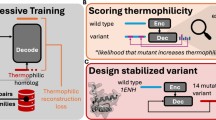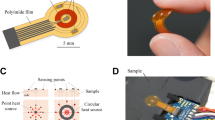Abstract
HOMOPOLYPEPTIDES have long been considered as model systems for the study of protein conformation1,2, and synthetic homopolypeptides are now available commercially. Solid state and polymer physics have advanced to where the simpler homopolypeptides can be treated theoretically by lattice dynamics and experimentally by the physical techniques of neutron, infrared and Raman spectroscopy, which are more suited to the examination of the optical vibrational modes of a molecule which are of energy higher than, say, 70 cm−1. Specific heat methods, on the other hand, have the advantage that by measuring at low temperatures (1–20 K) only the acoustic modes are appreciably excited thermally (a temperature of 1 K corresponds approximately to 0.7 cm−1). Moreover, the specimen need not be in single-crystal form, and at low temperature the vibrational spectrum is easier to interpret, and the useful picture of Debye3 holds well. The specific heat measurements reported here are believed to be, by a factor of 100, the lowest temperature specific heat measurements made on a biopolymer4. Such measurements can give information about the proportion of a protein which is in alpha-helical or beta-sheet structure, and also will be necessary in evaluating the basic thermodynamics of enzyme reactions5.
This is a preview of subscription content, access via your institution
Access options
Subscribe to this journal
Receive 51 print issues and online access
$199.00 per year
only $3.90 per issue
Buy this article
- Purchase on SpringerLink
- Instant access to full article PDF
Prices may be subject to local taxes which are calculated during checkout
Similar content being viewed by others
References
Poly-α-amino Acids (edit. by Fasman, G. D.) (Dekker, New York, 1967).
Katchalski, E., Sela, M., Silman, H. I., and Berger, A., in The Proteins (edit. by Neurath, H.), 2, second ed. (Academic Press, New York, 1964).
Kittel, C., Introduction to Solid State Physics, ch. 5 (Wiley, New York, 1967).
Haly, A. R., Abu-Isa, I., and Dole, M., J. Appl. Polymer Sci., 9, 893 (1965).
Benzinger, T. H., Nature, 229, 100 (1971).
Tarasov, V. V., New Problems in the Physics of Glass (OTS, Department of Commerce, District of Columbia, 1963).
Tarasov, V. V., and Yunitskii, G. A., Russ. J. Phys. Chem. (in Russian), 39, 2077 (1965).
Iwakura, Y., Uno, K., and Oya, M., J. Polymer Sci., A–1, 6, 2165 (1968).
Iwakura, Y., Uno, K., and Oya, M., J. Polymer Sci., A–1, 5, 2867 (1967).
Finegold, L., Techniques in Metals Research (edit. by Passaglia, E.) (Wiley, New York, 1972).
Choy, C. L., Hunt, R. G., and Salinger, G. L., J. Chem. Phys., 52, 3629 (1970).
Zoller, P., Fehl, D. L., and Dillinger, J. R., Physics Lett., 32 A, 228 (1970).
Reese, W., J. Macromol. Sci.—Chem., A 3, 1257 (1969).
Wunderlich, B., and Baur, H., Adv. Polymer Sci., 7, 151 (1970).
Fulde, P., and Wagner, H., Phys. Rev. Lett., 27, 1280 (1971).
Fanconi, B., Small, E. W., and Peticolas, W. L., Biopolymers, 10, 1277 (1971).
Krishnan, M. V., and Gupta, V. D., Chem. Phys. Lett., 6, 231 (1970).
Aebersold, D., and Pysh, E. S., J. Chem. Phys., 53, 2156 (1970).
Knaell, K. K., and Scott, R. A., J. Chem. Phys., 54, 566 (1971).
Lieb, E. H., and Mattis, D. C., Mathematical Physics in One Dimension (Academic Press, New York, 1966).
Author information
Authors and Affiliations
Rights and permissions
About this article
Cite this article
FINEGOLD, L., CUDE, J. Specific Heat Measurements of Poly-(L-Alanine) at Low Temperatures (1.8–20 K) and Aspects of One Dimensionality. Nature 237, 334–335 (1972). https://doi.org/10.1038/237334a0
Received:
Revised:
Issue date:
DOI: https://doi.org/10.1038/237334a0



